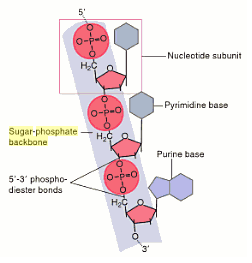DNA (Deoxyribonucleic Acid
- The name Deoxyribonucleic Acid comes from the sugars and phosphates that make the structure.
-The sugars of the helix is called Deoxyribose (the ribose structure has lost a oxygen atom), and the iron phosphate is an acid.
-The nucleric is also found in the nuclei of cells, and is also acidic.
- The DNA is a polymer, and this mean that it is a molecule that consisting of many repeating units called monomers. The repeating units in DNA is called Nucleotides.
- Nucleotides holds together the molecules Deoxyribose (sugar), phosphate iron and nitrate.
- The ladder rung structures have two bases and is where genetic information is stored.
- The sugar and phosphate elements are used to construct the long strands that hold the bases, the bases themselves are made up of Nitrogen.
- There are two groups of bases, the Pyrimidines and the Purines. These bases are placed together in complementary pairs, which are as so:
Adenine (A) (Purines)
Thymine (T) (Pyrimidines)
Guanine (G) (Purines)
Cytosine (C) (Pyrimidines)
These complementary base pairings are held together by hydrogen bonds.
- The two backbone strands are antiparallel in direction and this is because of the carbon molecule structure.
- The Deoxyribose carbons are numbered 1 to 5 in the clockwise direction, the third carbon in every deoxyribose sugar connects to the phosphate (5th Carbon) group of the molecule below it.
- This antiparallel formation gives the twisted double helix appearance.
- DNA is found in every living organism. However, some organisms have a different structure for their DNA.
- Bacteria (Prokaryotes) do not have a membrane bound nucleus and their DNA structure float freely in the cytoplasm.
- Bacteria have a single circular chromosome found in the centre of the cell, they also have extra circles of DNA called Plasmids,
-These Plasmids hold extra genes, these can be coding for antibiotic resistance and increases their chance of survival.
- Eukaryotes (meaning organisms that cells nucleus are enclosed in a membrane) have linear DNA structures and are tightly wound around proteins called Histones.





No comments:
Post a Comment
Note: Only a member of this blog may post a comment.